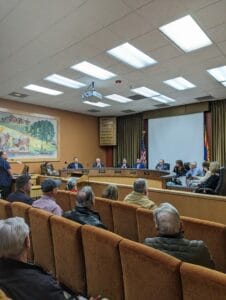By Dan Frosch | The New York Times
SLICK ROCK, Colo. — The Dolores River bends through southwestern Colorado like a gooseneck, shaded by red rock canyons that leave those who pass through here breathless.
The Burros uranium mine, with the Dolores River in the background. Wildlife groups fear that uranium and radon will seep into the water surrounding the shuttered mines.

Hidden from the riverbanks, behind cottonwoods and mule deer tracks, are different, artificial formations. Off a nearby road, an aging tower marks the property of the Burros Mine, partly owned by State Representative Don Coram. Heaps of rocks tinged with the greenish hue of uranium are visible. Abandoned mining equipment lies strewn about. A darkened portal is gated shut. Downstream, another mine, owned by the Cotter Corporation, lies similarly silent.
Despite bursts of activity from 2003 through 2008, most uranium mines scattered across Colorado have largely been out of production for decades, a testament to fluctuating mineral prices. Now the future of these mines is at the crux of a dispute that could set a precedent for how they are handled.
Environmental groups in Colorado contend that many of the state’s 33 uranium mines should be forced to clean up, given that uranium mining, which flourished here during the cold war, has gone dormant. In legal filings, they have alleged that companies like Cotter are skirting potential costs associated with cleanup, which is required by the state after an operation shuts down.





